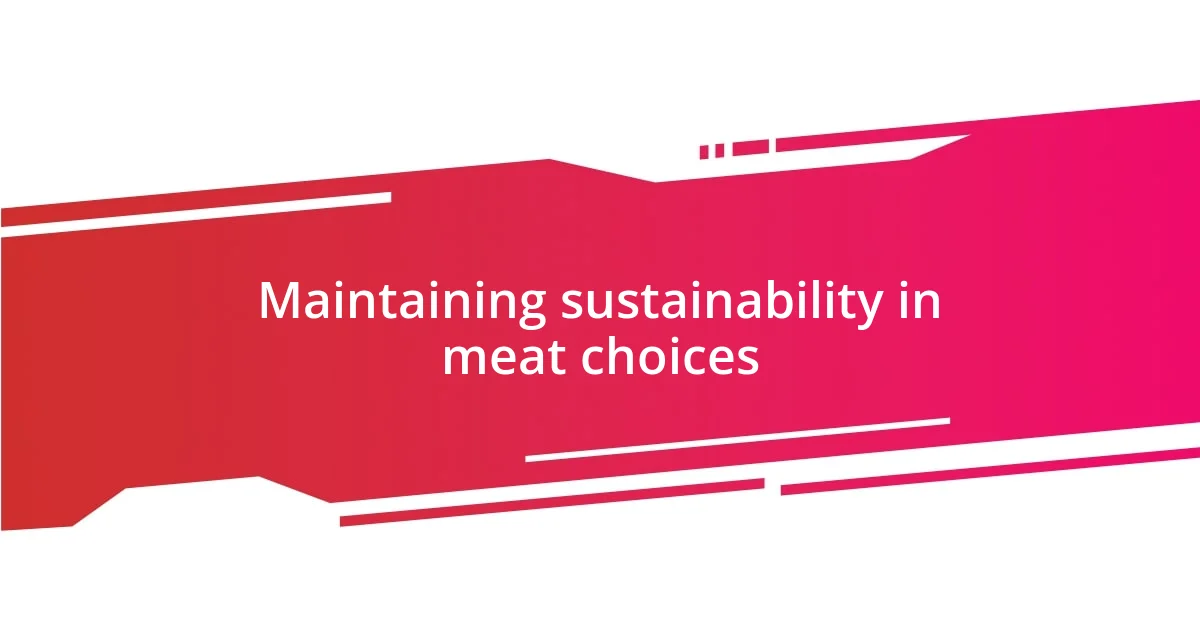Key takeaways:
- The shift towards plant-based diets reflects broader health and environmental concerns, driving culinary creativity and more mindful eating choices.
- Choosing high-quality, ethically sourced meat enhances flavor and nutrition, while also fostering awareness of sustainable practices in food consumption.
- Meal planning and flexibility in ingredient choices promote creativity and reduce food waste, supporting a balanced and sustainable dietary approach.

Understanding meat consumption trends
Meat consumption trends are shifting dramatically, influenced by a variety of factors like health awareness and environmental concerns. When I first noticed friends opting for plant-based alternatives, I wondered—what motivates such a big change? Seeing them thrive on these diets made me curious about my own habits.
I remember attending a dinner party where the main dish was a vibrant veggie stir-fry instead of the usual meat centerpiece. It hit me then that people are not just cutting back on meat; they’re reimagining meals entirely. This experience opened my eyes to how culinary creativity can reshape traditional eating patterns while satisfying our taste buds.
As I explored these trends further, I realized that many consumers today are searching for quality over quantity. It made me reflect on my own choices—am I seeking more mindful, ethical sources of meat? I found that these trends aren’t just numbers; they reflect a broader desire for a healthier lifestyle and a sustainable future.

Reasons for changing my diet
Changing my diet didn’t happen overnight; it evolved from a mix of curiosity and necessity. As more friends shared their stories about plant-based living, I felt both inspired and motivated to reassess my own food choices. I began to notice how good I felt after lighter meals, prompting me to explore healthier options.
Here are some key reasons behind my decision to change my diet:
- Health: I started experiencing digestive discomfort, which pushed me to focus on more balanced meals.
- Environmental impact: Learning about the carbon footprint of meat consumption made me reflect on my choices.
- Culinary exploration: I was excited to try new flavors and recipes as I shifted towards more plant-based meals.
- Community influence: Seeing friends thrive on their diets fostered a sense of camaraderie that I wanted to join.

Choosing high-quality meat options
When I learned to choose high-quality meat, my approach transformed completely. At first, I relied on popular grocery store brands, but as I delved deeper, I realized the importance of sourcing meat that aligns with my values. Visiting local farms opened my eyes to the care that goes into raising animals ethically, and it made me appreciate the taste and quality of grass-fed beef over conventional options.
I’ve often found myself wondering how much of an impact these choices could have on my health and the environment. For instance, when I tried organic chicken from a nearby farmer, the difference in flavor was so striking that it changed the way I cooked and enjoyed meals. I learned that high-quality meat isn’t just about nutrition; it’s also a journey of discovering the stories behind the food on my plate.
As I navigated through the world of meat options, I made it a point to ask questions about sourcing and farming practices. It became a conversation starter with butchers and farmers. They often shared their experiences, which enriched my understanding of what high-quality meat truly is. Here’s a quick comparison of some key aspects to consider when evaluating meat options:
| Meat Option | Key Features |
|---|---|
| Conventional | Often mass-produced with less focus on animal welfare |
| Grass-Fed | Healthier omega-3 fatty acids and better flavor profile |
| Organic | No antibiotics or hormones, promotes sustainable farming |
| Local | Supports economy, usually fresher and more transparent sourcing |

Incorporating plant-based alternatives
In my quest to incorporate plant-based alternatives, I discovered that the transition wasn’t just about replacing animal products; it was about embracing a new culinary adventure. I distinctly remember the first time I made a chickpea curry, and the aroma that filled my kitchen was intoxicating. It opened my eyes to the vast, flavorful world of legumes and grains that I had previously overlooked.
As I further explored plant-based options, I stumbled upon an unexpected joy in experimenting with different textures and flavors. One evening, I prepared a hearty quinoa salad loaded with vibrant vegetables and a zesty lemon dressing. The satisfaction I felt was palpable—it wasn’t merely a meal; it became an expression of creativity and well-being. Could this be the missing piece to my dietary puzzle? I learned that not only did my body respond positively, but my palate also expanded in thrilling ways.
Reflecting on this journey, I realized that plant-based eating is more than just a trend; it’s a lifestyle that encourages mindfulness and sustainability. Joining a local plant-based cooking class became a game-changer for me. The sense of community and shared passion for nourishing foods was invigorating. We often shared tips, and one lesson that stuck with me was the power of spices to transform simple plant ingredients into something extraordinary. It’s incredible how such small adjustments can elevate a dish, forging a deeper connection to my food and cutting down my reliance on meat.

Balancing nutrition with meat trends
Balancing nutrition with meat trends has become a fascinating puzzle for me. I remember one particular week when I decided to track my meals closely. It was enlightening to see that while I was incorporating more high-quality meats, I was also inadvertently cutting down on portion sizes. The richer flavors and better textures of grass-fed options made smaller servings feel satisfying, allowing me to appreciate each bite while keeping my nutrient intake in check.
Engaging with seasonal eating became an exciting element in this balance. I once tried making a roasted vegetable and chicken dish using what was freshest at the local farmers’ market. The medley of colors and flavors was like a celebration on my plate. I found that when I focused on nutrition alongside meat trends, it encouraged me to experiment more with side dishes and plant-based ingredients, elevating my nutritional profile even further.
Moreover, I pondered if enjoying meat should also include a sense of responsibility toward my health. What if we viewed our plates as more than just meals, but rather as opportunities for balance? Each time I incorporated vegetables alongside higher-quality meats, I felt a sense of pride knowing I was supporting both my well-being and local producers. It’s interesting how a mindful approach to my diet has enriched not just my health, but also my conversation around food with friends and family. They often ask, “How do you make those choices?” It invites meaningful discussions about nutrition, sustainability, and the joy of eating well.

Meal planning for dietary changes
Meal planning became essential when I made the switch to a more plant-based diet. I remember sitting down on a Sunday afternoon, surrounded by colorful produce and grains, mapping out my meals for the week. It felt almost meditative to plan, as I realized that being intentional with my choices not only made grocery shopping easier, but it also helped me reduce food waste. How often do we let uneaten food go to waste because we didn’t have a plan? This new practice not only saved me money but also invigorated my creativity in the kitchen.
I also learned to embrace batch cooking, which transformed my weeknight dinners. During one particularly busy week, I prepped a big batch of lentil soup on a rainy Sunday, and it became my saving grace. Each time I opened the fridge and saw that vibrant soup waiting for me, I felt a wave of relief wash over me. Isn’t it comforting to have nutritious meals ready to go? It allowed me to avoid the temptation of quick, less healthy options after a long day, showcasing how planning can align my diet with my evolving values.
My approach also involved incorporating flexibility into my meal planning. One week, after discovering a new recipe for zucchini noodles, I started to play with interchangeable ingredients depending on what I had on hand. It hit me that meal planning doesn’t have to be rigid. Isn’t it freeing to adapt based on what excites you or what’s available? This approach fostered a sense of spontaneity while keeping my meals diverse and interesting, which is crucial when trying to maintain new dietary habits.

Maintaining sustainability in meat choices
One of the most rewarding adjustments I’ve made in my meat choices revolves around supporting sustainable practices. I recall a weekend spent visiting a local farm where cows grazed freely, and the farmers spoke passionately about their rotational grazing methods. It struck me how my meat choices could directly influence not only my health but also the health of the environment. By prioritizing pasture-raised and ethically sourced meats, I felt more connected to the food I consumed and the stories behind them. Isn’t it empowering to know that our choices at the dinner table can contribute to a healthier planet?
Exploring the concept of eating lesser-known cuts has been another eye-opening experience for me. One evening, I decided to prepare braised beef shank instead of the usual steak. The deep flavors and tender texture blew me away, while also highlighting the importance of reducing waste in meat consumption. Why should we only choose popular cuts when so many other options are waiting to be discovered? This shift not only supports sustainable practices by fully utilizing the animal but also encourages me to become a more adventurous cook.
I also pay close attention to portion sizes, which is crucial in promoting sustainability. I distinctly remember a dinner when I plated a small serving of grass-fed beef alongside a generous pile of seasonal vegetables. This balance not only made the meal more colorful, but it also left me feeling satisfied without overindulging. It’s interesting how shifting the focus from meat as the centerpiece to vegetables and whole grains can lead to a more sustainable lifestyle. Could it be that rethinking how we view meat will uncover richer, more fulfilling meals?















